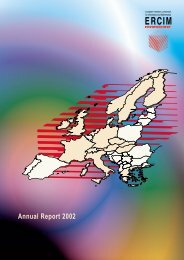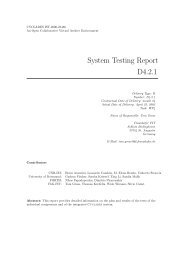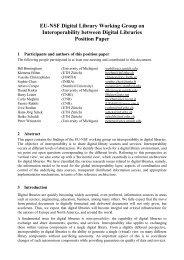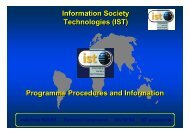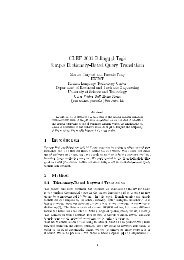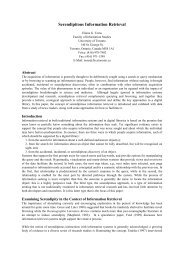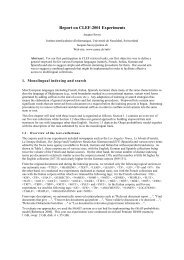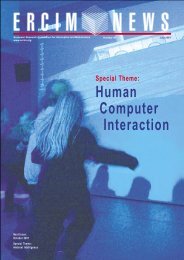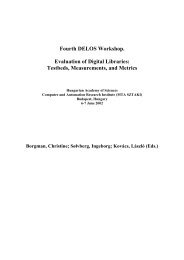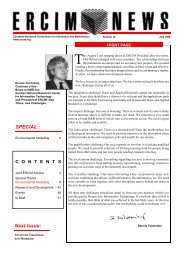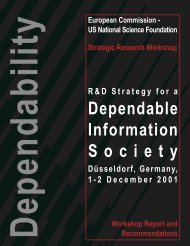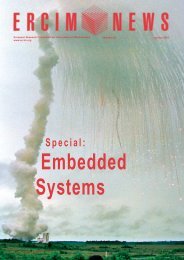Towards a Platform for Widespread Embedded Intelligence - ERCIM
Towards a Platform for Widespread Embedded Intelligence - ERCIM
Towards a Platform for Widespread Embedded Intelligence - ERCIM
Create successful ePaper yourself
Turn your PDF publications into a flip-book with our unique Google optimized e-Paper software.
SPECIAL THEME: <strong>Embedded</strong> <strong>Intelligence</strong><br />
Networking Semantic Services<br />
<strong>for</strong> Pervasive Computing<br />
Networking Semantic Services <strong>for</strong> Pervasive Computing<br />
by Valerie Issarny, Nikolaos Georgantas and Sonia Ben Mokhtar<br />
With computing and communication<br />
By Valerie<br />
capabilities<br />
Issarny, Nikolaos<br />
now embedded<br />
Georgantas<br />
in more<br />
and<br />
and<br />
Sonia<br />
service<br />
Ben Mokhtar<br />
behaviour protocols. A signifi-<br />
more physical objects in the surrounding environment and with most users cant enabler <strong>for</strong> dealing with these issues<br />
With computing and communication capabilities now embedded in more and more physical<br />
carrying wireless computing devices, the pervasive computing vision pioneered is the Semantic Web and in particular the<br />
by Mark Weiser is being realised<br />
objects<br />
more<br />
of<br />
than<br />
the surrounding<br />
ever. Nevertheless,<br />
environment<br />
such an abundance<br />
and most users<br />
Semantic<br />
carrying<br />
Web<br />
wireless<br />
Services<br />
computing<br />
paradigms,<br />
devices, the<br />
of ambient capabilities in<br />
pervasive<br />
the open, dynamic<br />
computing<br />
pervasive<br />
vision<br />
environment<br />
pioneered by<br />
naturally<br />
Mark Weiser<br />
which<br />
is<br />
allow<br />
more<br />
description<br />
than ever<br />
of<br />
becoming<br />
service<br />
possible.<br />
comes with high heterogeneity, Nevertheless, which hinders such their abundance ad hoc integration of ambient into rich capabilities semantics in and the behaviour open, and dynamic rigorouspervasive<br />
pervasive applications. Within environment the INRIA ARLES naturally team, comes we are investigating with high heterogeneity, efficient reasoning which about hinders the <strong>for</strong>mer. their ad Tackling hoc integration<br />
solutions to pervasive heterogeneity into rich pervasive building upon applications. semantic Within service-oriented the INRIA both ARLES semantics team, and we behaviour are investigating hetero- efficient<br />
architectures. solutions to pervasive heterogeneity building upon semantic geneity in service-oriented a combined way architectures.<br />
is still an<br />
open, challenging issue, further exacer-<br />
Various pervasive applications Various may bepervasive<br />
call <strong>for</strong> applications computing paradigms may be that provisioned enable bated in today’s by the fact networked that semantic environments. reasoning Figure 1<br />
provided in today's networked illustrates environexploitation<br />
loose, dynamic of the devices coupling in among the surroundings hetero- is to a create compute-intensive smart spaces <strong>for</strong> task, users. tooIn<br />
such an<br />
ments. Figure 1 illustrates exploitation environment, of the geneous nomadic resources. user may Service-oriented<br />
in particular benefit demanding from a large <strong>for</strong> the display wireless, that resource- is nearby to watch<br />
the networked devices to multimedia create smartcontent<br />
architectures provided (SOA) by a have local emerged media server, as an while constrained the content devices will of automatically the pervasive be switched<br />
spaces <strong>for</strong> users. In such an environment, to the user’s smart appropriate phone display computing as soon paradigm as other users environment. get close to preserve the user’s privacy. This<br />
the nomadic user may, in particular, application ben- may resolving further be a extended number of to heterogeneity<br />
share experience with others. For instance, assume that the user<br />
efit from a large display nearby is actually to watchin<br />
a issues. holiday However, resort, watching pervasive an advertisement environ- As <strong>for</strong> part available of the excursions. work of the Then, INRIA the user may<br />
multimedia content provided will by to a local get feedback ments have about further the excursion, introduced which new chal- may be ARLES obtained team, through on the blogs development maintained of by other<br />
media server. The content will nearby automati- visitors lenges on their <strong>for</strong> handhelds SOA both at and/or middleware the Internet. and distributed The user may systems even enabling will to the look perva- at alternative<br />
cally be switched to the user's excursions, smartwhether<br />
at application advertised layer. at nearby Regarding resorts, the at tourist sive in<strong>for</strong>mation computing vision, offices we or are even devising on the Internet.<br />
phone display as soon as other Actuator users get resources <strong>for</strong>mer, like devices displays, need to and dynamically software resources enablers like <strong>for</strong> pervasive blogs, multimedia services. We streams and<br />
close, to preserve the user's privacy. advertisements This detect on the services Web, all available constitute in the networked open net- capabilities have, in particular, that may investigated conveniently interop- be composed<br />
application may further be to extended realize a topervasive<br />
worked application environment enabling and to interact a holiday withplanner<br />
erability <strong>for</strong> nomadic enablers and users. their integration<br />
share experiences with others. For<br />
instance, assume that the user is actually<br />
in a holiday resort, watching an advertisement<br />
<strong>for</strong> available excursions. The<br />
user may wish to get feedback about the<br />
excursion, which may be obtained<br />
through blogs supplied by other nearby<br />
visitors on their handhelds and/or the<br />
User detection<br />
Internet. The user may even wish to look<br />
at alternative excursions, whether advertised<br />
at nearby resorts, at tourist in<strong>for</strong>mation<br />
offices or even on the Internet. Figure 1: Integrating resources in user-centric smart spaces.<br />
Actuator resources such as displays and<br />
Figure 1. Integrating resources in user-centric smart spaces<br />
software resources such as blogs, multimedia<br />
streams and advertisements Pervasive on the computing them. This environments requires enabling as interoper- the one exemplified within the base above SOA embed architectural networked style. devices,<br />
Web, all constitute networked possibly capabili- wireless, ability from of both various discovery application and communi- domains, e.g., The mobile resulting and SOA personal style <strong>for</strong> computing, pervasive consumer<br />
ties that may conveniently be electronics, combinedand<br />
cation homeprotocols, automation as services domains. are This imple- diversity computing of devices offers along two with key functionali- the ones of networks<br />
to dynamically create a pervasive and of appli- software mented infrastructures on top of diverse call <strong>for</strong> middleware computing paradigms ties, each that one enable vertically loose, integrating dynamic coupling<br />
cation providing a holiday among planner heterogeneous <strong>for</strong> plat<strong>for</strong>ms resources. (eg, UPnP Service-oriented used in the home architectures related advanced (SOA) have features emerged in the middle- as a well-serving<br />
nomadic users. such paradigm and resolving Jini in a number the mobile of heterogeneity domain). issues. ware and However, in the application pervasive environments layer, as have<br />
further introduced Regarding new challenges the latter, applications <strong>for</strong> SOA both need at tomiddleware<br />
depicted in and Figure at application 2. First, semantic-rich layer. Regarding the<br />
Pervasive computing environments, <strong>for</strong>mer, devices like compose, need to dynamically in an ad hoc fashion, detect services available interoperable in the service open networked discovery enables environment and<br />
the one shown above, embed to networked interact with available them. This at the requires specific enabling time and place, interoperability the locating of both of discovery networked and services communication<br />
devices, possibly wireless, from protocols, various as services which have are implemented been developed on top indepen- of diverse according middleware to their plat<strong>for</strong>ms semantic (e.g., descriptions. UPnP used in the<br />
application domains, eg, mobile home and and perJini<br />
in dently the mobile without domain). a priori mutual Regarding knowl- the latter, In the applications middleware need layer, to discovery compose in isan<br />
ad hoc<br />
sonal computing, consumer fashion electronics, services edge. available The major at the challenges specific are time enabling and place, achieved, which despite have been the possible developed coexis- independently<br />
and home automation domains. without This a priori common mutual understanding knowledge. Major and adaptation challenges tence concern of various enabling discovery common protocols, understanding by and<br />
diversity of devices, along with adaptation those of of the of the semantics of of the the services being associated, interworking and between interoperability them, which between fur- service<br />
networks and of software infrastructures, behavior protocols. associated A significant and interoperability enabler <strong>for</strong> between dealing with ther includes these issues middleware is the Semantic data type Web and in<br />
particular the Semantic Web Services paradigms, which allow description of service semantics and<br />
behavior and rigorous reasoning about the <strong>for</strong>mer. Tackling both semantics and behavior<br />
36 <strong>ERCIM</strong> News No. 67, October 2006



